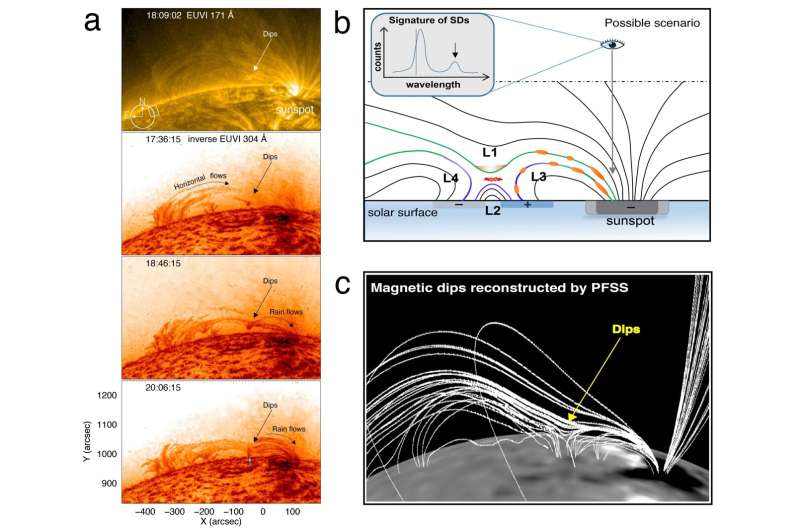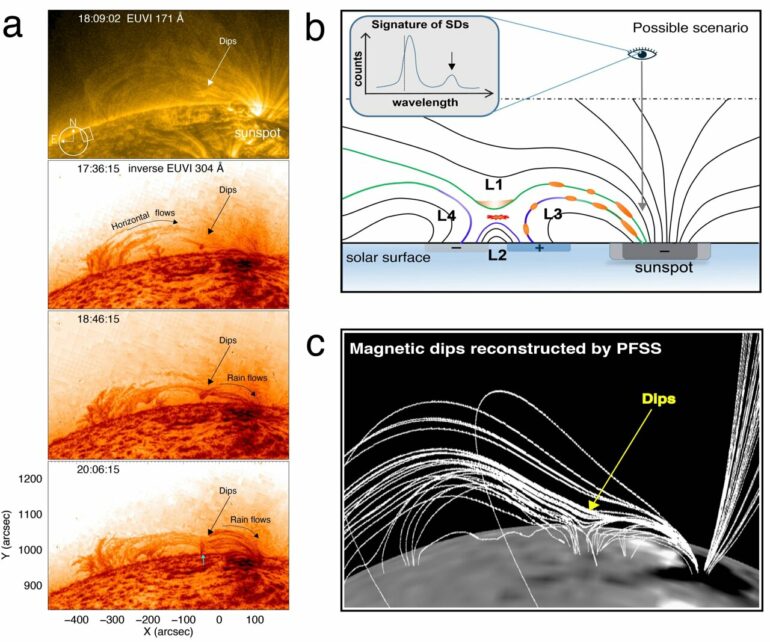Solar transition region supersonic downflows (SDs) are downward falling mass flux toward the sunspots. This phenomenon commonly exists above most sunspots. In IRIS spectra, SDs are often observed as strongly redshifted secondary emission peaks with a speed of around 100 km/s, and they last for at least several hours.
How these long-lived SDs form, and what mechanisms are responsible for their substantial and stable mass supply, remained unclear since their discovery in the 1980s. Recently, Dr. Li Leping from the National Astronomical Observatories of the Chinese Academy of Sciences (NAOC) and his collaborators have provided new clues for these unresolved questions. They proposed that the SDs originate from the cooling and condensation of hot coronal plasma in magnetic dips facilitated by magnetic reconnection.
Their study was published in Astronomy & Astrophysics on March 15.
Employing joint observations from a ground-based Chinese solar telescope, the New Vacuum Solar Telescope (NVST), and several satellites including SDO, STEREO, and IRIS, the researchers investigated a series of transition region SDs in NOAA AR 12740 and their associated coronal activities. “We clearly track the formation of a quasi-steady SD event for the first time,” said Dr. Chen Hechao from Peking University, the first author of the study.

Fig. 2. A possible scenario for the formation of reconnection-facilitated coronal condensation and its induced quasi-steady SDs from the observations, schematic diagram, and PFSS model. © Chen Hechao
Dual-perspective extreme ultraviolet (EUV) images revealed that these SDs originate from the cooling and condensation of coronal plasma in dips along a large-scale closed loop system that connects the sunspot and a remote region. In the dips, repeated coronal rain forms and continuously flows along these loops towards the sunspot, resulting a transition region SD event.
“This dual-perspective joint observations from multiple telescopes provide us a very valuable opportunity to directly track the coronal origin of these SDs,” said Prof. Tian Hui from Peking University, one corresponding author of the study.
Based on imaging observations and magnetic field extrapolations, the researchers proposed a reconnection-facilitated coronal condensation scenario for SD formation. In this scenario, the dips form slowly via reconnection between two sets of loops with opposite polarities. The coronal plasma in the dips then quickly cools and condenses via thermal instability. In this process, condensed materials accumulate as a transient prominence in the dips and thus form a mass reservoir available to feed a long-lasting rain flow.
“As the rain persistently drains into the sunspot along different trajectories in funnel-like structures, i.e., sunspot plumes, the funnel effect of this geometry further reshapes the clumpy rain at the coronal height into a more elongated and stream-like one when reaching the lower atmosphere,” said Dr. Chen. “This leads to the quasi-steady SDs.”
“This work shows a new extended application of our previous reconnection-facilitated coronal condensation scenario that was initially proposed for coronal rain formation,” said Dr. Li, the other corresponding author of the study.
The drainage of coronal rain and its resultant SDs last for more than two hours, indicating a substantial mass supply by the coronal condensation. In the dip, the total mass of condensation and condensation rate were calculated. They are indeed large enough to sustain this long-lived SD event. “SDs thus play an important role in the chromosphere-corona mass cycle of the sunspot atmosphere,” said Dr. Li.
More information:
Hechao Chen et al, Coronal condensation as the source of transition-region supersonic downflows above a sunspot, Astronomy & Astrophysics (2021). DOI: 10.1051/0004-6361/202142093
Provided by
Chinese Academy of Sciences
Citation:
Scientists reveal source of supersonic downflows into sunspots (2022, April 6)
